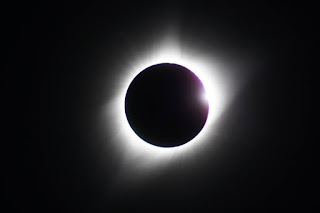brings a dovetail of two disparate radio operating events: The International Lighthouse Event (ILLW) and the
North American QSO Party (NAQP).
Once in a lifetime another event traverses thru the confluence of two regularly associated events. For 2017, after the ILLW and NEQP events were
a distant memory, Monday morning brought us SEQP - the Solar Eclipse QSO Party.
SEQP is a once-in-a-lifetime event with the intent being to collect data regarding the solar effects
on radio communication. Calling CQ a lot allowed the Reverse Beacon Networks (RBN) to track our transmissions. Data collected from these transmissions along with log data submitted after the event can be fed into spreadsheets, allowing discernment of the nuances of atmospheric cooling as the eclipse-effect migrated across the United States.
 |
| CH-250 & Horiz. VEE (underside) |
To bring IILW, NAQP, SEQP all together
I reserved the W6K callsign. Using W6K allowed my signal-data to stand out
amongst non 1x1 callsigns.
W6K was another portable operation from W7AYT's QTH in Concord Ca. In addition
to using the location's CH-250 Vertical,
I configured a Cobra dipole as a horizontal
VEE 7.5 mh.
With an old 3-position coax switch I am able
to select either of those antennas or parallel them together.
The Yaesu FT-1000mp's tuner managed
to sort things out quite nicely.
While W6K made a grand total of 41 QSOs in the SEQP (4 more than made in NAQP), just as important were the ongoing CQ calls made throughout
my 6 hours of operating in the event.
I kept an eye on DXMap displays
to know when the W6K callsign
was being spotted.
While spots occurred on 10 & 15
meters, no callers appeared. Additionally, tuning those 2
bands, I heard no workable
stations.
 |
| Grid Squares worked by W6K |
Beyond countries, states, provinces and zones.
for radio purposes, the world is split into what
are known as Grid Squares.
W7AYT's QTH is in grid square: CM78xx.
During the SEQP event, W6K managed to work
32 different gird squares in the U.S. and Alaska.
My Cabrillo log submission will allow the LCR
(Log Check Robots) to computer-analyze the log
data and build a complex database of cross-reference
QSO data, in conjunction with SPOT information
from the skimmers and RBN networks.
I found engaging in a Monday operating event
to be an interesting experience.
 |
| 20 & 40 meter W6K spots |
Because it was a daytime event
most of the QSOs on the west
coast occurred on the upper
bands, with a brief stint on
40 meters.
As such, I did not have to deal
with the usual evening 40-meter intentional QRM situation.
Did you work the Solar Eclipse QSO party?
How many Grid Squares are in your log?
Is W6K in one of them?
 |
| W6K Ending Screen |
[CLICK HERE] to read this second installment.




No comments:
Post a Comment